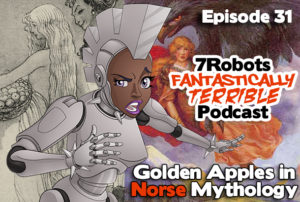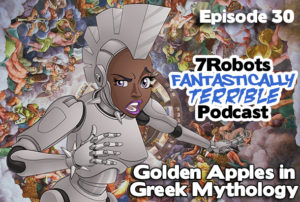How to Listen
The best way to support the show is to like our episodes and follow us. You don’t know how much this helps us out! Liking each episode you enjoy let’s us know…that you liked it. So, if you like our work, we’ll keep doing it. Woohoo!
If you go that extra mile and leave a comment, we can see your name and personally thank you live at the end of show! 
(⌐■_■)ノ♪♬ Script and music by Suzy Dias
Listen here:


Watch our mini documentaries:
Latest News and Episodes
Get all the latest episodes, breaking news, opinions, weather, traffic, and more…Um, minus the weather and traffic and add a lot of laughs. 
Listen or watch on YouTube
Episode 34: The Green Man is a Global Phenomenon
We’re going to put on our Indiana Jones outfit and travel the globe searching for the Green Man. We were surprised by how global the Green Man motif is. He’s a superstar from Scotland to Egypt to Mesopotamia to Thailand, and everywhere in between. We’ll travel around the world and put a pin in each stop along the way.
The Fantastically Terrible Character or Creature this week is Mélusine. Mélusine is a feminine water spirit that resembles a mermaid. You’ve probably seen her on the logo of a little coffee shop called Starbucks. She’s popular in the folklore of northern France. She’s a good wife and mother, but give her one day to be by herself. It’s not much to ask is it? When her husband decides one day to see what she does alone on her day of rest, he sees that she’s transformed into something that makes mermaids seem normal. *
Origins of the name “Green Man”
The origin for the name “green man” can be traced to Lady Raglan. In 1939, she applied the name “Green Man” in her article, “The Green Man in Church Architecture” in “The Folklore Journal”. She did not invent the term, but she was the first to publish it. She used it to describe a common architectural motif.
In general, there are two distinctive types of Green Man. The first is a leaf mask, where there is a face obscured by leaves, leaving only eyes and mouth visible. The second is a face in which leaves grow out of the nose or mouth; these are sometimes described as ‘disgorging’ masks. Some have only a suggestion of leafiness, while others are completely obscured by foliage.
Lady Raglan was very influenced by Sir James Frazier’s 1922 book on mythology, religion and folklore, “The Golden Bough”. In her article, she concluded: “This figure I am convinced, is neither a figment of the imagination nor a symbol, but is taken from real life, and the question is whether there was any figure in real life from which it could have been taken. The answer, I think, is that there is but one of sufficient importance, the figure variously known as the Green Man, Jack-in-the-Green, Robin Hood, the King of May and the Garland King, who is the central figure in the May Day celebrations throughout Northern and Central Europe.” [Read more…]
Middle Ages
♫ Music for this section: Collegium Musicum of Yale University School Of Music Volume 1 by Paul Hindemith [listen here…]
The Middle Ages was the height of popularity for green man motifs in Medieval churches in the 13th and 14th centuries. It was also the time when the symbol took on darker tones. The images were more ominous and the symbol went from a natural vibe to a more sinister one. But times have changed.
Rosslyn Chapel
There’s one place in particular, Rosslyn Chapel in Scotland, that has over 100 green men, inside and out. Some are easy to spot while others are hidden away from view, which they only discovered recently while doing conservation work. Most of the faces are disgorging leaves or vines from the mouth or nose. There are only a few classic foliate heads.
According to RosslynChapel.com, “We have smiling men, scowling men, men baring savage looking teeth, and something that we think is quite unique to us – green men that age as you walk round the building. We have what we call our Green Boy, such a youthful face, then the adult bearded men, and finally one or two green skeletons! So this might explain why people feel that the green man represents the passage of life, birth, living, death and renewal.” [Read more…]
The Green Man in Medieval Architecture
— Various https://commons.wikimedia.org/wiki/Category:Green_Man and https://pt.wikipedia.org/wiki/Homem_Verde
— Exeter Cathedral in Devon, UK https://spiritofalbionblog.blogspot.com/2010/07/grace-and-beauty-of-exeters-green-man.html
— Winchester Cathedral in Hampshire, UK https://www.winchester-cathedral.org.uk/gallery/the-choir-stalls/
— Norwich cathedral in Norfolk UK (a few) https://inexplicabledevice.blogspot.com/2016/05/the-green-men-of-norwich-cathedral.html
— St. Collen’s church, Llangollen, UK Green Bishop carving https://coleckc.wordpress.com/category/st-collen/
— St Mary’s Church, Burwell, UK https://blogs.loc.gov/folklife/category/green-man/?loclr=blogflt
— L’église Saint Prix et Saint Cot, France https://www.petit-patrimoine.com/fiche-petit-patrimoine.php?id_pp=89337_7
— St. Lorenz Church, Nuremberg, Germany https://blogs.loc.gov/folklife/2021/02/what-was-the-green-man/
— A painting by the Dutch and Flemish Renaissance artist, Pieter Brueghel the Elder (1525–1569), known as “The Wild Man,” https://blogs.loc.gov/folklife/category/green-man/?loclr=blogflt
— The Wilder-Mann-Brunnen (Wild Man Fountain) in Salzburg, Switzerland (1620) https://commons.wikimedia.org/w/index.php?search=Wilder-Mann-Brunnen&title=Special:MediaSearch&go=Go&type=image
Fontaine du Sauvage à Delémont, Switzerland (1576) https://commons.wikimedia.org/wiki/File:B-Delemont-Fontaine-du-Sauvage.jpg
— Casa de Arizón, Sanlúcar de Barrameda, Spain (1685–1749) https://gl.wikipedia.org/wiki/O_home_verde
Ancient Egypt: Osiris
♫ Music for this section: Mysterious Atmosphere Music by Spanac [listen here…]
One of the oldest gods of birth, death and resurrection is Osiris. Osiris was the first pharaoh of Egypt. He was the god of fertility, agriculture, and after his death, the underworld and resurrection. After Osiris was murdered by his brother Set, Isis and Anubis performed the first Egyptian embalming to prepare Osiris for the afterlife. However, he was reborn in the land of the dead. But before he departed, Isis had sex with him and became pregnant with Horus (the falcon-headed god).
Osiris is often depicted with green skin. This feature, along with his association with fertility, death and rebirth give him a close symbolic connection to the Green Man.
— https://www.worldhistoryedu.com/birth-symbols-resurrection-of-osiris/
— https://www.ancient-egypt-online.com/horus.html
“Green” Osiris in Art
— Statue de Ptah-Sokar-Osiris XXVIe dynastie ; Basse Epoque (-664 – -332) https://collections.louvre.fr/en/ark:/53355/cl010019185
— Statue de Ptah-Sokar-Osiris XXVIe dynastie ; Basse Epoque (-664 – -332) https://collections.louvre.fr/en/ark:/53355/cl010027912
— Stèle cintrée XXVe dynastie (fin XXVe dyn) (attribution d’après style) (-780 – -656) https://collections.louvre.fr/en/ark:/53355/cl010014152
— Papyrus funéraire XXIe dynastie ; XXIIe dynastie (attribution d’après style) (-1069 – -731) https://collections.louvre.fr/en/ark:/53355/cl010003278
— Coffret à serviteurs funéraires rectangulaire époque ramesside (-1295 – -1069) https://collections.louvre.fr/en/ark:/53355/cl010335971
— Stèle cintrée ; stèle à 2 registres époque ptolémaïque (attribution d’après style) (-299 – -200) https://collections.louvre.fr/en/ark:/53355/cl010014445
Ancient Greece and Phrygia
The ancient Greeks and Phrygians, worshipped Attis, a God of Vegetation. He was associated with Cybele the “Great Mother”. She was later adopted by the Romans and Trojans. The followers os Attis were eunuchs (no action downstairs). The self-mutilation, death and resurrection of Attis represents the fruits of the earth which die in winter and are reborn in the spring. According to Ovid’s “Metamorphoses”, Attis transformed himself into a pine tree. We clearly see a similarity between Attis and the Green Man with vegetation, rebirth and trees.
— https://en.wikipedia.org/wiki/Attis
— Attis as a God of Vegetation https://link.springer.com/chapter/10.1007/978-1-349-00635-9_35
Ancient Greece and Rome: Dionysus
Dionysus or Bacchus, depending on whether your Greek or Roman, is the god of wine, fertility, ritual madness and religious ecstasy. There are definitely some parallels with the Green Man. Dionysos represents death, life and going wild!
I’m going to read this from Britannica.com, Dionysus is “a nature god of fruitfulness and vegetation, especially known as a god of wine and ecstasy. The occurrence of his name on a Linear B tablet (13th century bce) shows that he was already worshipped in the Mycenaean period, although it is not known where his cult originated. In all the legends of his cult, he is depicted as having foreign origins.” [read more…]
Mildenhall Treasure
Much of the Dionysian imagery overlaps with the Green Man. Dionysos is often shown wearing leafy crowns, masks or having vines with grapes in his hair. However, his faces are not usually covered in ivy. The Great Dish of Bacchus at the British Museum, which is part of the Mildenhall Treasure, is a fantastic example.
The Great Dish also known as the Oceanus Dish or as the Neptune Dish. It has concentric circles and at the very centre is the head of a marine deity, probably Oceanus, the personification of the ocean. However, you’d swear it was a Green Man. His beard is made of seaweed with dolphins emerging from his hair. I guess it’s the underwater version of a hair pick. He’s surrounded by nereids (sea-nymphs), tritons and other mythical and natural sea-creatures, while the deep outermost circles show his followers dancing, playing musical instruments and drinking. [Read more…]
Dionysus / Bacchus in Art
– The Great Dish of Bacchus at the British Museum https://en.wikipedia.org/wiki/Mildenhall_Treasure
– Dionysos pics http://my-favourite-planet.de/english/europe/greece/attica/athens/acropolis/acropolis-photos-01-036.html
– Dionysus-Bacchus (2C AD) https://www.khm.at/objektdb/detail/50644/?offset=25&lv=list
– “Bacchus Richelieu”, 1793 https://artmuseum.princeton.edu/collections/objects/18645
– Tête de Bacchus Vers 1727-1730 https://collections.louvre.fr/en/ark:/53355/cl020010149
– Bacchus 1600 – 1700 https://collections.louvre.fr/en/ark:/53355/cl010091812
– Primaticcio, Francesco (dit Le Primatice) (1504-1570), entourage de Ecole bolonaise https://collections.louvre.fr/en/ark:/53355/cl020553805
– Casque orné d’un masque de feuillage 1685 https://collections.louvre.fr/en/ark:/53355/cl010095330
– Retombée d’arcade décorée d’une tête d’homme et de feuillage 1300 – 1325 https://collections.louvre.fr/en/ark:/53355/cl010093576
– Harpocrate (couronne pschent, double bourgeon, couronne de feuillage) époque romaine (d’après style) (-30 – 395) https://collections.louvre.fr/en/ark:/53355/cl010005430 and https://art.rmngp.fr/fr/library/artworks/statuette-d-harpocrate_bronze
– Fragment de tympan décoré de deux motifs semi-circulaires ornés d’un masque grotesque de la bouche duquel s’échappent des feuillages vers 1100 – 1150 https://collections.louvre.fr/en/ark:/53355/cl010093012
The Celts: Cernunnos
♫ Music for this section: Guifrog – Beyond the Warriors [listen here…]
During the Gallo-Roman period, the Celtic horned god Cernunnos was followed in north-eastern Gaul, which included France, Luxembourg, Belgium, most of Switzerland, and parts of Northern Italy, the Netherlands, and Germany. He was also worshipped by the Celtiberians in Portugal and Spain.
Unfortunately, we don’t have much information on Cernunnos due to the lack of records. But lucky for us, there were wonderful artists! They depicted him with horns or antlers and sitting in a cross-legged position. They think he had something to do with nature, fertility, animalism, travel, and similar themes. No one knows for sure. He’s associated with many animals like stags, horned serpents, dogs, bulls, and rats. [Read more…]
There is a wonderful image on the “Pillar of the Boatmen” column located today in the Musée National du Moyen Age (Museum of the Middle Ages), in Paris, France. [Visit the museum…]
Mesopotamia: Hatra
♫ Music for this section: Sehgah by Asghar Bahari [listen here…]
* He was an Iranian musician, not Iraqi, but his music is beautiful!
Hatra was an ancient city in Upper Mesopotamia located in present-day northern Iraq. Hatra flourished in the 2nd century, and was destroyed and deserted in the 3rd century. According to Wikipedia, “Hatra became an important fortified frontier city and played an important role in the Second Parthian War, withstanding repeated attacks by the Roman Empire. During the 2nd century CE the city repulsed sieges by both Trajan (116/117) and Septimius Severus (198/199)”. [Read more…]
The Levant: The Green One
There are a couple of notable reference from the Middle East. One is a man known as Khidir or, “The Green One”. He’s described in the Quran as a righteous servant of God with great wisdom and mystic knowledge, but he’s not mentioned by name. I thought he was worth mentioning because according to Wikipedia, “the name “al-Khiḍr” shares exactly the same triliteral root as the Arabic al-akhḍar or al-khaḍra, a root found in several Semitic languages meaning “green” or “verdant”. Therefore, the meaning of the name has traditionally been taken to be “the Green One”. [Read more…]
This is a quote from rosslynchapel.com “He is an Islamic immortal who is revered by Sufi mystics. In Islamic folklore, Moses, or Musa, makes a journey with a strange creature in green robes. But he is never described as being covered in leaves. We have on occasions been told that the interior of Rosslyn Chapel shows signs of Sufi symbolism.” [Read more…]
The other reference is a depiction of the Green Man at the Museum of Istanbul in Iraq . A giant leafy head sits at the top of a column, which is worth looking at (click here).
Asia: The Glorious Face
In Asia where we’ll find the “glorious face” instead of the foliate head. It’s the name they give to the symbol of a fierce monster face with huge fangs and a gaping mouth. It’s common in the iconography of Hindu temple architecture in India and Southeast Asia. It’s used as an ornamental motif in art. [read more…] https://en.wikipedia.org/wiki/Kirtimukha
If you’re watching our the video version of our podcast, you’ll see many incredible pictures of faces incorporating many the Green Man motifs in India, Indonesia, Nepal, Cambodia and Thailand.
Indonesia https://folklorethursday.com/material-culture/the-green-man/
East (various) https://en.wikipedia.org/wiki/Kirtimukha
The Glorious Face in Architecture
— Kirtimukha at Prasat Kok Po A, Angkor, Siemreap, Cambodia 9th century
— Kala-Makara, a Kirtimukha of 9th century Javanese Sailendra Borobudur portal, Indonesia
— Kirtimukha above a Hindu temple entrance in Kathmandu, Nepal
— A Thai Kirthimukha at ‘Wat Baan Ping’ in Chiang Mai, Thailand
Fantastically Terrible Character or Creature: Mélusine
Mélusine is a feminine spirit that resembles a mermaid and she is popular in the folklore of northern France. She lives in rivers and springs and other fresh waters, and is sometimes featured with wings or one or two tails that could either be a serpent’s or a fish tail.” [Read more…]
There are quite a few stories about Melusine, but the most famous one revolves around the Lusignan family in France.
One day, Count Raymondin of Poitiers was hunting in the forest and got lost. While trying to find his way out of the forest, he came upon a clearing with a beautiful pavilion with a gorgeous fountain in the middle and two handmaidens tending to their lady.
Raymondin was instantly smitten by the beautiful lady. They spend time together and he fell in love with her. He asked her to marry him, but she had one condition. Every Saturday she was not to be disturbed by anyone. Not him or any of his servants. Raymondin thought it was a bit odd, but not a deal breaker. So he agreed and took Melusine and her ladies back to his castle.
But Melusine did not need his money. She was a very wealthy woman and she built him a splendid castle. Check and mate. After they married, Melusine and Raymondin had three sons, each of them had a physical imperfection.
Raymondin’s brother thought all of this was very strange and suggested that they spy on Melusine and see what she did in the privacy of her bedroom on Saturdays. The following Saturday, they hid themselves in her bedroom to spy on her as she took her bath. Oh brother! They go the shock of their lives. Where her legs normally appeared was a green serpent’s tail. The brothers didn’t know what to do. They were flipping out! Melusine was no slouch and she sensed that she was being watched. She saw the two horrified spies and she let out a horrible cry! Then she transformed into a dragon and flew out of the castle window, never to be seen again.
Links
★ 15 Creatures from French Folklore to Haunt Your Dreams Tonight
★ Melusine (wiki)
★ The Legend of Melusine
Personal Thank You!
We want to thank everyone for listening. If you enjoy our show that’s fantastic! If you haven’t subscribed or followed us yet, please do. It really helps us out with our statistics on iTunes, Soundcloud and YouTube.
Honestly, we don’t really know you’re thinking unless you let us know. So, please LIKE the episode or even leave a comment and say hello. We’d love to hear from you.
Additional Links
★ BBC The surprising roots of the mysterious Green Man (with video)
★ History of the Green Man
★ The Green Man – An Ancient Celtic Symbol Of Rebirth
★ Green Man (wiki)
★ Unraveling the Nature and Identity of the Green Man
★ Foliate Head
★ What Was the Green Man
★ The Fascination of Green Men: Winchester’s Contribution by Julie Adams (PDF)
★ Sir Gawain and the Green Knight (Spark Notes)
You might also like the following episodes…
Videos related to this subject…
Remember to check out Ghost Metal!
Our FREE comic on Webtoon and now on Tapas! Read each week as we serve you bite-sized sci-fi & horror stories on a macabre menu of detestable delights. A new episode is up every Friday for your abhorrent amusement.
(◣_◢) Read on WEBTOON
(⌐■_■) Read on TAPAS
😵💫 We’re creating 100 original sci-fi / horror stories!
Additional Resources
🎧 iTunes Podcast
🎧 https://www.youtube.com/7Robotsinc
🔗7Robots Fantastically Terrible Podcast (info)
★ Ghost Metal
☆ Ghost Metal on Webtoon
☆ Ghost Metal on Tapas
★ Wolf Boy
☆ Wolf Boy and the Magical Warriors on WEBTOON
★ About Us
★ Contact
★ 7 Robots Shop








